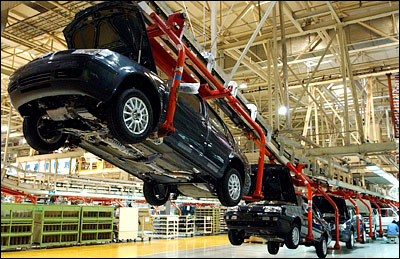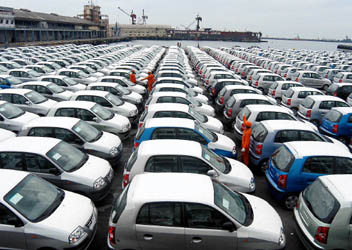 |
| Image Source: china.org.cn |
The automobile industry has been growing at a strong pace since its revival post the financial meltdown in 2008. Sales of light and heavy-duty vehicles have been up driven by renewed consumer confidence in the economy and higher spending. We believe that the growing automobile industry presents significant growth opportunity for Corning. Corning manufactures substrates and filters for catalytic converters that help in controlling emissions from light and heavy-duty vehicles. An increase in production of automobiles will drive sales of Corning’s substrates and filters, and help boost its revenues.
 |
| Image Source: linkedin.com |
Additionally, Corning stands to benefit from the use of Gorilla Glass in automobiles. Gorilla Glass is a protective cover glass generally used in consumer electronics such as smartphones, tablets and notebooks to protect the display. However, it has recently started to gain some popularity in the automotive industry as well. The use of Gorilla Glass in automobiles will open up an entirely new revenue stream for Corning.
Corning’s Substrates and Filters Market
In 2013, Corning’s Environmental Technologies business generated $919 million, 12% of Corning’s overall revenues. The segment deals with manufacturing substrates and filters for light and heavy duty vehicles. These substrates and filters help curb harmful emissions. Corning sells its substrates and filters, Celcor and Duratrap respectively, to automotive exhaust systems manufacturers, who then sell to automobile manufacturers. We believe that stringent emission standards and growing vehicle production will continue to drive Corning’s Environmental Technologies’ sales.
Vehicles will soon have to be upgraded to maintain compliance with new emission standards
Government authorities issue emission standards in order to curb harmful emissions from vehicles, power plants and refineries. The automobile industry is one such industry that is obligated to adhere to these emission standards. To ensure that their vehicles are compliant with emission standards, they resort to the use of emission control systems. With newer and stricter emission standards, automobile manufacturers have to keep upgrading their emission control systems in order to remain compliant.
 |
| Image Source: toostep.com |
This has a positive impact on the automotive exhaust systems market, which includes manufacturers of automotive substrates and filters.
- The U.S. will be implementing its Tier 3 emission standards for light-weight vehicles starting 2017, which requires a 75% reduction in emissions. For heavy-duty vehicles such as trucks and buses, it presently follows the 2007 Heavy Duty Highway Rule
- For light-duty vehicles, China implemented its China IV emission standards in July 2013 and is working towards implementing China 5 standards nationwide by January 2018. For heavy-duty vehicles, China is currently following the China IV emission standards and plans to roll out the China 5 standards soon.
- India currently follows Bharat Stage III standard, which is in line with Euro III standard, for both light and heavy-duty vehicles. The Bharat IV standard, which is in line with Euro IV standard, is currently being followed in select cities, but will be implemented across the country by 2015.
Corning recently announced that it has developed a product to deal with cold start emissions, i.e. vehicular emissions that occur during the first few minutes after starting the engine. Traditional ceramic or metal substrates take time to heat up to their optimal operating temperatures, and are thus ineffective in cleaning emission during the first few minutes. Within these few minutes, gasoline vehicles generate around 70% of their total emissions. Corning’s new substrate, developed from floral material, allows the system to heat up faster leading to more efficient cleaning of emissions in the first few minutes after an engine is started. Considering that the new U.S. emission standards require a reduction in emissions by 75%, cleansing of cold start emissions will be key. Corning’s new substrate, FLORA, will likely see a high demand due to its effectiveness against cold start emissions and should help increase its market share in the automotive exhaust systems market. At present, Corning occupies close to 3% of the automotive exhaust systems market.
Growing automotive production shall drive sales of substrates and filters
Economic recovery and growing consumer confidence and spending has stimulated the demand for automobiles, the global production of which grew by around 25 million units from 2009 to 2013. Automobile production is expected to grow by 21 million units by 2021 driven by demand from developing markets such as China and the reviving European automobile industry.
- Recovery of domestic demand in Europe and their exports to U.S. and China will help stimulate the European automotive industry, which has been suffering due to weak economic conditions. The European automobile output is expected to increase by 4% per year between 2015 and 2017, compared to 1% in 2014.
- The North American automobile production will remain strong driven by continued investments in the automobile industry by major automobile manufacturers. Additionally, the availability of cheap labor and land in Mexico is attracting attention of automotive Original Equipment Manufacturers (OEMs) across the globe.
Gorilla Glass has Significant Growth Opportunity in the Automobile Industry
Gorilla Glass is one of Corning’s best selling products, contributing 11% towards overall company revenues in 2013. Gorilla Glass is primarily sold to consumer electronics manufacturers such as Apple, Samsung, Dell and HP. But due to its scratch resistance and high durability, it is gaining popularity within the automotive industry.
Presently, the consumer electronics industry consumes around 0.9 billion square feet of Gorilla Glass, up from around 0.5 billion square feet in 2011. The use of Gorilla Glass in the automotive industry opens up an opportunity to tap into the 5.5 billion square feet demand for automotive glass. If Corning manages to capture 5% of this market, it could see its revenue from Gorilla Glass grow by around 30%.
Corning has been actively pursuing applications of Gorilla Glass in the automobiles as interior windows, windshields and sunroofs. Due to its light weight and strength, BMW has chosen Gorilla Glass for the interior windows of their i8 sports car. The glass will act as an acoustic barrier against unwanted noise. Corning has collaborated with Pittsburgh Glass Works, a manufacturer of automotive glass, which will help in expanding Gorilla Glass’ reach to more mainstream vehicles and in higher numbers.
Corning believes that it might take another three to four years before it can truly realize any significant revenue from the use of Gorilla Glass in automobiles. This is because the technology involved behind Gorilla Glass automotive application is still at a very nascent stage and would require a considerable time to be perfected to be produced at a larger scale. Additionally, the immense competition in the automotive glass market may deter its growth in the segment.
Follow Arnaud Massartic on Twitter for interesting news about automobiles.









